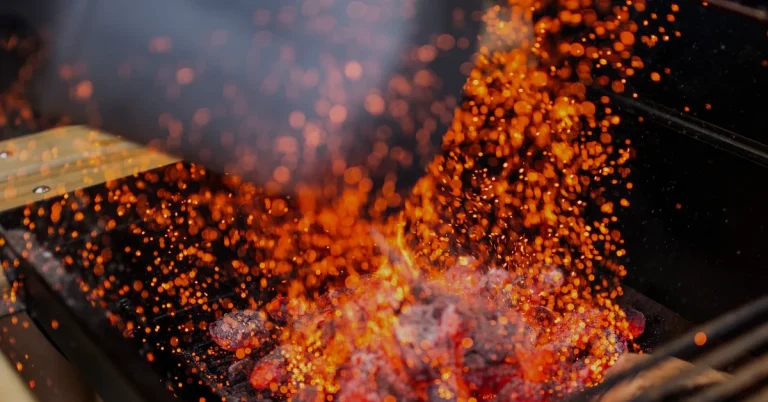Lump Charcoal vs Briquettes Smoking

When you fire up the grill, choosing the right charcoal can make all the difference in your barbecue. Lump charcoal and briquettes are the two main types of charcoal you’ll find, each with its special qualities.
Lump charcoal is perfect for grilling because it’s made from real pieces of wood, giving your food a pure, smoky flavor. On the other hand, briquettes are a reliable alternative made from compressed charcoal dust and other additives. They burn longer and more consistently, but some say they can leave a slight aftertaste.
So, which one should you choose? Well, it depends on what you are looking for. If you want that authentic, woody flavor and don’t mind a little variation, go for lump charcoal. But briquettes may be your best bet if you want steady, reliable heat and a long burn time.
Ultimately, it’s all about personal preference and what works best for your grilling style. So, fire up that grill, experiment with both, and see which brings you closer to barbecue perfection.
Here is the quick comparison table of Lump Charcoal vs Briquettes Smoking:
| Features | Lump Charcoal | Briquettes |
| Source | Hardwood pieces | Compressed charcoal dust and binders |
| Additives | None | May contain binders and fillers |
| Burning Temperature | Higher (up to 700°F) | Lower (around 500°F) |
| Burning Speed | Faster | Slower, more consistent |
| Smoke Flavor | More intense, natural wood smoke | Milder smoke may pick up some binder flavor |
| Temperature Control | Easier to adjust due to a faster response | More stable temperature but less responsive to adjustments |
| Ignition | Lights faster | May require a chimney starter |
| Ash Production | Less ash | More ash |
| Cost | Generally more expensive | Generally less expensive |
| Best for | Hot and fast smoking, searing | Low and slow smoking |
Overview Of Lump Charcoal vs Briquettes Smoking
Overview Of Lump Charcoal
Lump charcoal differs from briquettes because they are pieces of wood, not just crushed dust. It is made by burning wood in a low-oxygen oven, which darkens the pieces but does not burn them. Since lump charcoal pieces vary in size, it may take some getting used to.
When comparing lump charcoal to briquettes, remember that lump charcoal burns hotter and faster. This is great for grilling steaks over coals but requires careful temperature control.
Pros:
- All Natural: No added chemicals.
- Easy Heat Control: adjusts quickly with the wind.
- Less Ash: Leaves less dirt behind.
- Burns Hot: Great for grilling.
- Light Fast: Ready to cook in no time.
Cons:
- Uneven pieces: Sizes vary, making grilling difficult.
- Expensive: More expensive than briquettes.
- Burns quickly: temperature needs to be closely monitored.
Overview of Charcoal Briquettes
Charcoal briquettes are the most popular choice for grilling. They are made from sawdust and scraps of leftover wood, mixed with additives to hold them together. While they burn longer than lump coal, they are less hot. Some briquettes contain chemicals or lighter fluids, which can affect the taste of your food.
Charcoal briquettes are easy to find and come in consistent square shapes. They are perfect for casual backyard grilling because of their price and availability. Some manufacturers also offer flavoring options such as mesquite or applewood, adding extra flavor to your food.
Despite some drawbacks, charcoal briquettes remain an easy choice for many grillers, offering reliability and ease of use for delicious outdoor cooking.
Pros:
- It’s easy to find at stores everywhere, from hardware stores to gas stations.
- A cost-effective option for frequent grillers.
- Consistent size and shape make them user-friendly.
Cons:
- Additives used in production can change the taste.
- Limited in attaining highly high temperatures.
- Leave plenty of ash after use.
In summary, charcoal briquettes offer convenience and affordability, although their excess and ash residue should be considered when choosing your grilling fuel.
Lump charcoal vs briquettes – So Which Fuel is Better for You?
It depends on what you are cooking and how you like to grill. Briquettes are good if you want something familiar, easy to find, and consistent to burn. They are perfect for regular grilling without breaking the budget.
Lump charcoal, on the other hand, is perfect if you want a scorching fire or want to enhance the flavor of your food with a smoky touch. It’s also easy to clean afterward, and each piece can vary in size, offering versatility.
Whichever you choose, experimenting with both can add excitement to your grilling adventures.

I’m responsible for managing and coordinating content creation, distribution, and optimization. I’m the former editor-in-chief of PMQ Pizza Magazine and have written for several B2B food publications over the years, including Restaurant Hospitality, Flavor & The Menu, Restaurant Business, National Culinary Review, FSR, Restaurant Startup & Growth, and more.






